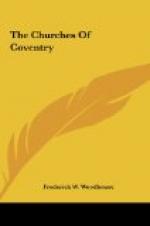Coming down to the opening of the Civil War we find that a few days before the raising of his standard at Nottingham Charles summoned the city to admit him with three hundred cavaliers, and received for answer that it was quite ready to receive his Majesty with no more than two hundred. Whereupon he retired in displeasure, and reappeared some days later with the threat to lay the city in ruins if it should persist in its disloyalty. The townsfolk being in no mind to receive a garrison, the King planted cannon against Newgate and broke down the gates but was met with a fierce musquetry fire from the walls, followed up by a vigorous sally, in which the citizens did much execution and took two cannon.
To prevent the like happening again, the walls were in 1662 breached in many places and made incapable of defence. Just one hundred years later New-gate was taken down, and others followed from time to time, until now there are left only the remains of two of the lesser ones—Cook Street Gate, a crumbling shell, and the adjacent Swanswell or Priory Gate, blocked up and used as a dwelling.
In 1771 was finally destroyed the famous Cross which had been built, 1541-3, by Sir William Hollis, once Lord Mayor of London, who came of a Coventry family. It was described by Dugdale as “one of the chief things wherein this City most glories, which for workmanship and beauty is inferior to none in England.” A few relics of it exist in St. Mary Hall, a statue of Henry VI, and, in the oriel, two smaller figures. So too does the very interesting contract for its building, which shows how much was left to the craftsman’s pride in his work and how little he was trammelled by conditions, save that the work was to be “finished in all points, as well in imagery work, pictures, and finials, according to the due form and proportion of the Cross at Abingdon.”
Another building, which was destroyed in 1820, was the Pilgrims’ Rest, a fine timbered house of three storeys, “supposed,” as the inscription upon it records, “to have been the hostel or inn for the maintenance and entertainment of the palmers and other visitors to the Priory.” Some pieces of carved work were patched together in the windows of the inn built on its site and there remain.
The modern history of Coventry, consisting of the ordinary events and vicissitudes of civic life and the changes and fluctuations in its trades, apart from that of its parish churches which is elsewhere given, does not come within the scope of this handbook.
[Illustration: Seal of the priory.]
[Illustration: Interior of the west end of the priory church.]
THE RUINS OF THE PRIORY AND CATHEDRAL CHURCH
The Priory buildings and grounds covered a large area to the North of the two parish churches on the gentle slope descending to the little river Sherbourne, Priory Row forming its southern boundary.




